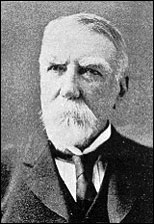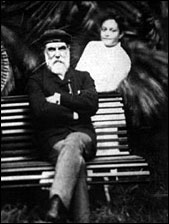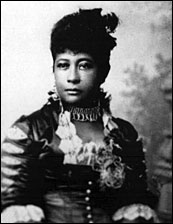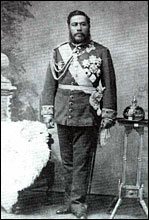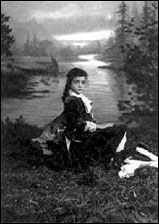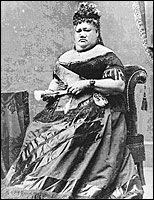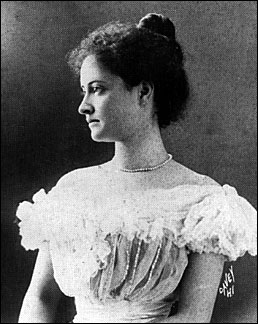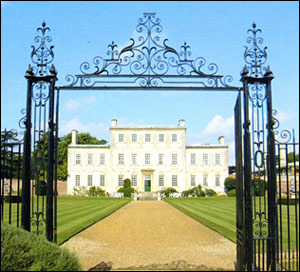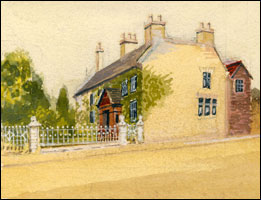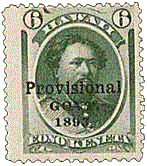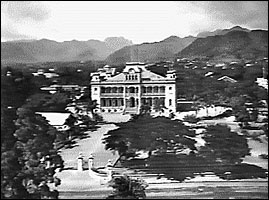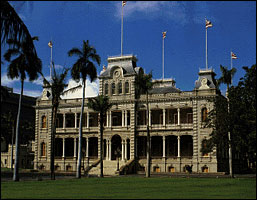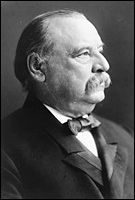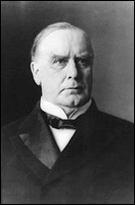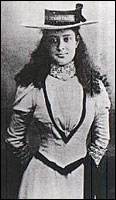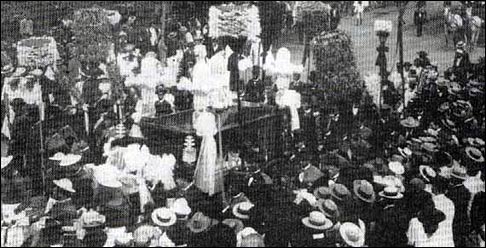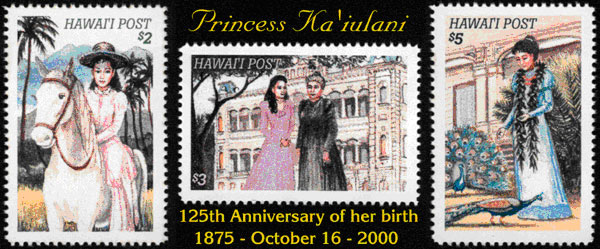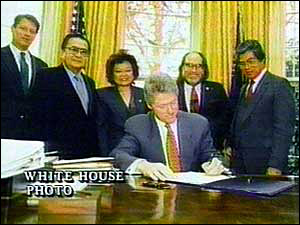| Article researched and compiled by Sarah Gilbert, 2005 | ||||||||||||||||
|
||||||||||||||||
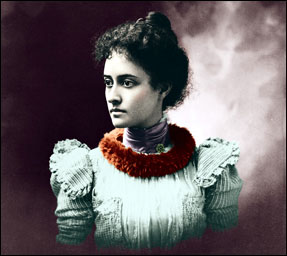 |
||||||||||||||||
| For a short time in the early 1890's Burton Latimer was the home of the Crown Princess of Hawaii whose short but tragic life touched the hearts of people across three continents. | ||||||||||||||||
|
The Beginning
but more commonly known as Princess Kaiulani - Kaiulani translates to “royal sacred one” or “the highest point of heaven”.
Her mother was Miriam Likelike, who was Hawaiian and her father was Archibald Cleghorn born and educated in
Thomas died in
He met an Hawaiian lady called Elizabeth and he went on to have three daughters with her, Helen, Rose and Annie, all this happened while he was still in his thirties. He had a home on
When he was 35, he married 19 year old Miriam Likelike (as
As Kaiulani’s Uncle and Aunt never had any children of their own, she was placed third in line to the throne from birth, which was celebrated with the tolling of bells and gun salutes.
The Cleghorn family lived at Ainahau in
Sadly on 2nd February 1887 aged 36, Princess Kaiulani’s mother Miriam died and left her 12 year old daughter sorrowful at the loss. However, the brave princess had the duty to stay in the palace for three weeks while her mother’s body was lying in state in the throne room and she was even part of the funeral procession.
Princess Kaiulani found a friend in Robert Louis Stevenson when he moved into one of the neighbouring residences in January 1889. He helped her in many ways at different times of her short life and with the loss of her mother still obviously affecting her, he brought some joy to the dark times that had already happened and would continue to happen to the teenager. Robert Louis Stevenson had been a friend of Miriam Likelike and was very taken with the family, and especially fond of the young Princess who thought that his hair was much too long! When he learned of the Princess’ father’s plan to send her abroad for schooling, he feared that the drastic change of climate would prove detrimental to her health, it was not his place however, to voice these fears to her father. Sadly his fears were to come true, and unfortunately very early on in her life.
A music box given to the Princess by Stevenson is amongst a collection at the Hulihe’e Palace in
He also prepared the Princess for her trip to
|
||||||||||||||||
|
||||||||||||||||
It was away on these ‘education trips’, that the Princess learned of Robert Louis Stevenson’s death aged 44 from a brain haemorrhage on December 3rd 1894, which affected her greatly.
Whilst in
|
||||||||||||||||
Although intelligent anyway, she studied French and German and was rated third in her French class. Art was also a subject she studied and enjoyed. Her stay in
Throughout her time here she missed her home land greatly and suffered a lot of headaches and illness. When she returned home for any length of the time, the heat was very often too much for her, and whilst her education continued forward,
|
||||||||||||||||
|
The monarchy - political and economical tensions
It was not long after this that Kaiulani was born whilst her uncle was in power. After his death in 1891, his sister Lili’uokalani became queen but in name only. Lili’uokalani unfortunately took on her brother’s political problems which had arisen over his dislike for the foreign businessmen and the high tax payments they had been forced to make because of their success. They had begun to believe that David Kalakua was corrupt and wanted him rid of his powers and were not happy that his sister had taken his role over. Sugar was the main support of the islands and they relied on the
In 1887, during King David’s reign, a group of planters and businessmen, seeking to control the kingdom politically and economically, formed a secret organization, the “Hawaiian League” made up of mostly Americans. The organizer was Lorrin A. Thurston who also went on to be the leader of the plan to overthrow the monarchy. King David was allowed to remain on the throne, with dethroning as a last resort if he refused to obey them. He finally signed the Bayonet Constitution which eliminated his power and gave all major voting rights to those that had the most money, these being the American and European business men and not the majority of native Hawaiians. When King David died his sister Lili’uokalani had to swear to uphold this constitution. Lorrin A. Thurston’s plan came into play for the annexation and overthrow of her, obviously kept secret as they were talking treason. Thurston went to
This new constitution that they wanted Lili’uokalani to uphold was refused by her Cabinet, fearing her enemies would use it against her. She stated that she was ready to discuss a new constitution but at a later date. The Annexation Club then claimed that by holding it off she had committed a revolutionary act. The then American minister John L. Stevens said he would not protect the queen and he would land troops to protect the Americans there if needed. The queen - to avoid bloodshed - surrendered Lili’uokalani wrote to President Cleveland of the
After investigations by James H. Blount, former chairman of the House Committee on Foreign Affairs, he ordered the troops back to their ship and the American flag to be replaced by the Hawaiian.
A search of Lili’uokalani’s home found a stash of arms buried in a flower garden and she was promptly arrested. Shortly after she was imprisoned at
|
||||||||||||||||
In 1896 after she was released, she went to
Hawaiian’s submitted a petition to Congress with 29,000 signatures opposing the annexation. Ultimately, the annexationists won and the sovereignty of
Sandford Dole was appointed the governor of the
|
||||||||||||||||
|
The Princess’s Quest Princess Kaiulani learned of all this news in three telegrams given to her by Theophilus Davies her “second father”, who had been chosen as her personal guardian and accompanied her to
QUEEN DEPOSED; MONARCHY ABROGATED; and BREAK NEWS TO PRINCESS. Kaiulani also received a letter from her father telling her about the rebels forming a Committee of Safety to organize their own government and that Sandford Dole had been appointed as a new leader but not by the will of the people. Kaiulani’s title of Princess had been stolen from her.
It was in that time in 1897 after Hawaii had become a republic that her health really started to be affected, what with the stress of what had been happening, the deaths of close people to her and the constant changing of climates through her travelling. However she also faced another loss that year when her half sister Annie died and the year after, Mr Davies was also taken from her by death. Princess Kaiulani had been described as “savage” and a “barbarian”, but the paparazzi of the day were quite surprised when meeting her that she was anything but. They were met and greeted by a beautiful young lady of strong personality, dressed in the latestAny attempts to disrespect
|
||||||||||||||||
|
Her loyalty to
This, along with the aforementioned death of Robert Louis Stevenson the following year, had a detrimental impact on the young woman’s health, and whilst back home in Hawaii, she sadly died at the tender age of 23, on the 6th March 1899. The story goes that she was out riding her horse and got caught in a tropical rainstorm; she developed rheumatic fever and never recovered. Many say she died of a broken heart, as she hadn’t been able to get
On the sad day of her death, the peacocks which roamed the grounds of her home started to make a tremendous din, and some were behaving so erratically that her father had to shoot some of the beautiful birds. It’s said they did this as they knew their Princess, who used to lovingly hand feed them, had passed away.
Kaiulani once said herself “I must have been born under an unlucky star, as I seem to have my life planned out for me in such a way that I cannot alter it….” It may be thought that her life ended with nothing but failure, but her story has given hope and inspiration to many people of all different walks of life, and it is easy to understand why. Kauiulani’s father wanted his 10-acre estate which he spent many tireless hours landscaping to be turned into a park as an eternal tribute to his daughter’s life, but the city of
Her life is by no means forgotten, with statues erected of her, displays in memory of her in museums, and on commemorative stamps such as those shown below. Even bridal gown shops and surf boards are named after her. In short,
|
||||||||||||||||
 On October 16th 1875, a baby girl was born in
On October 16th 1875, a baby girl was born in
